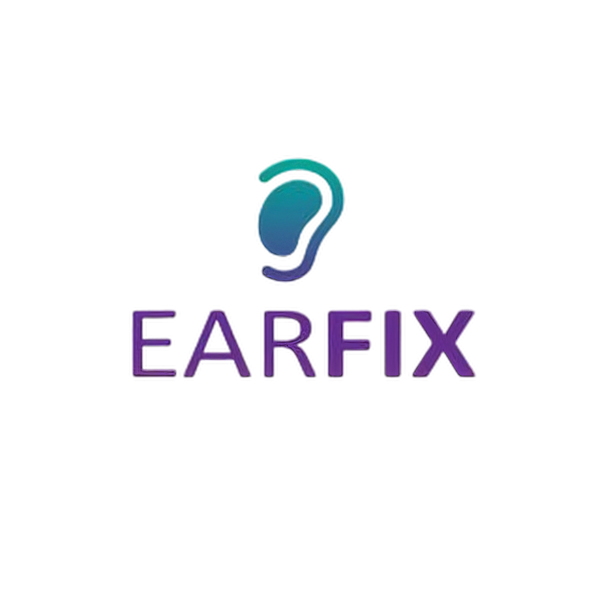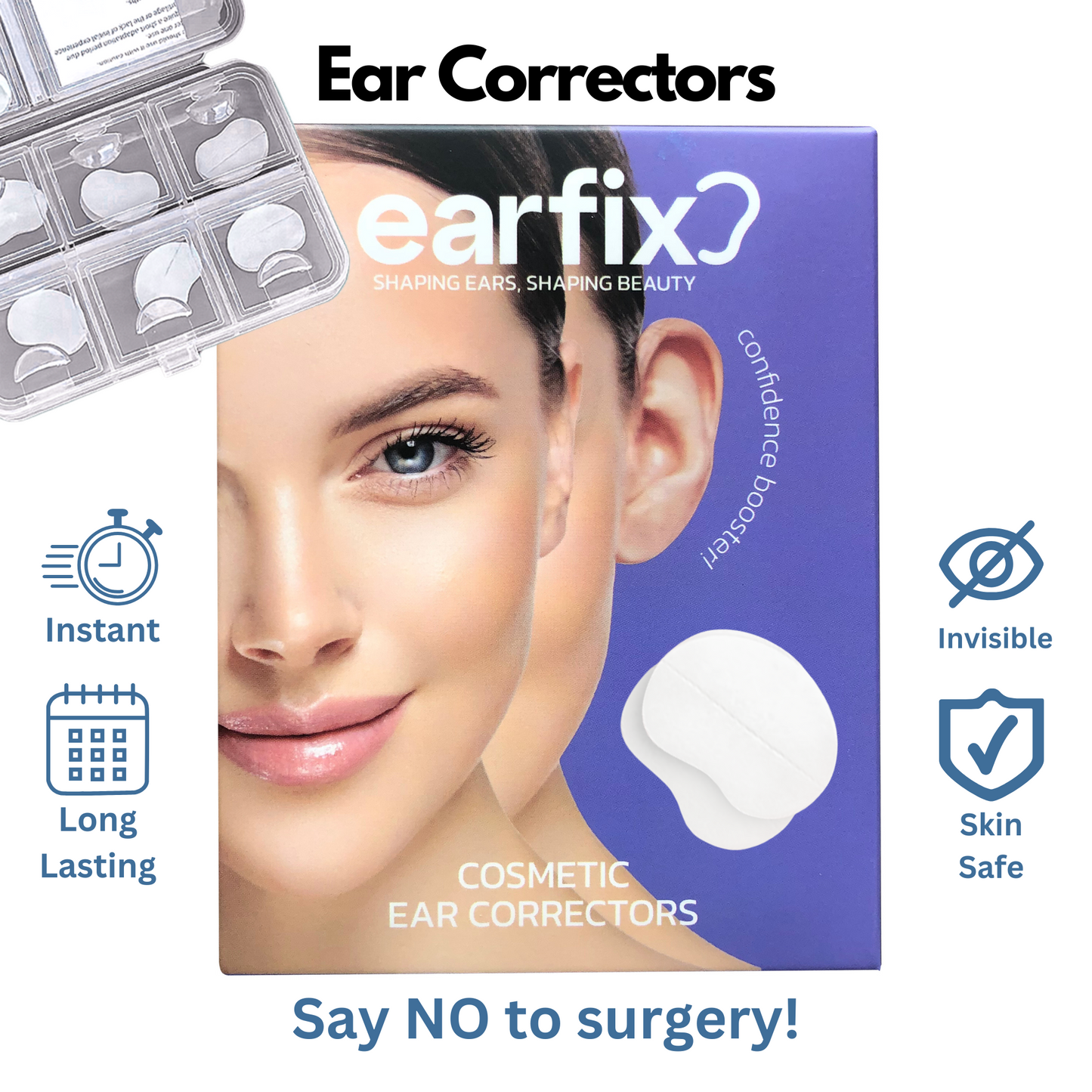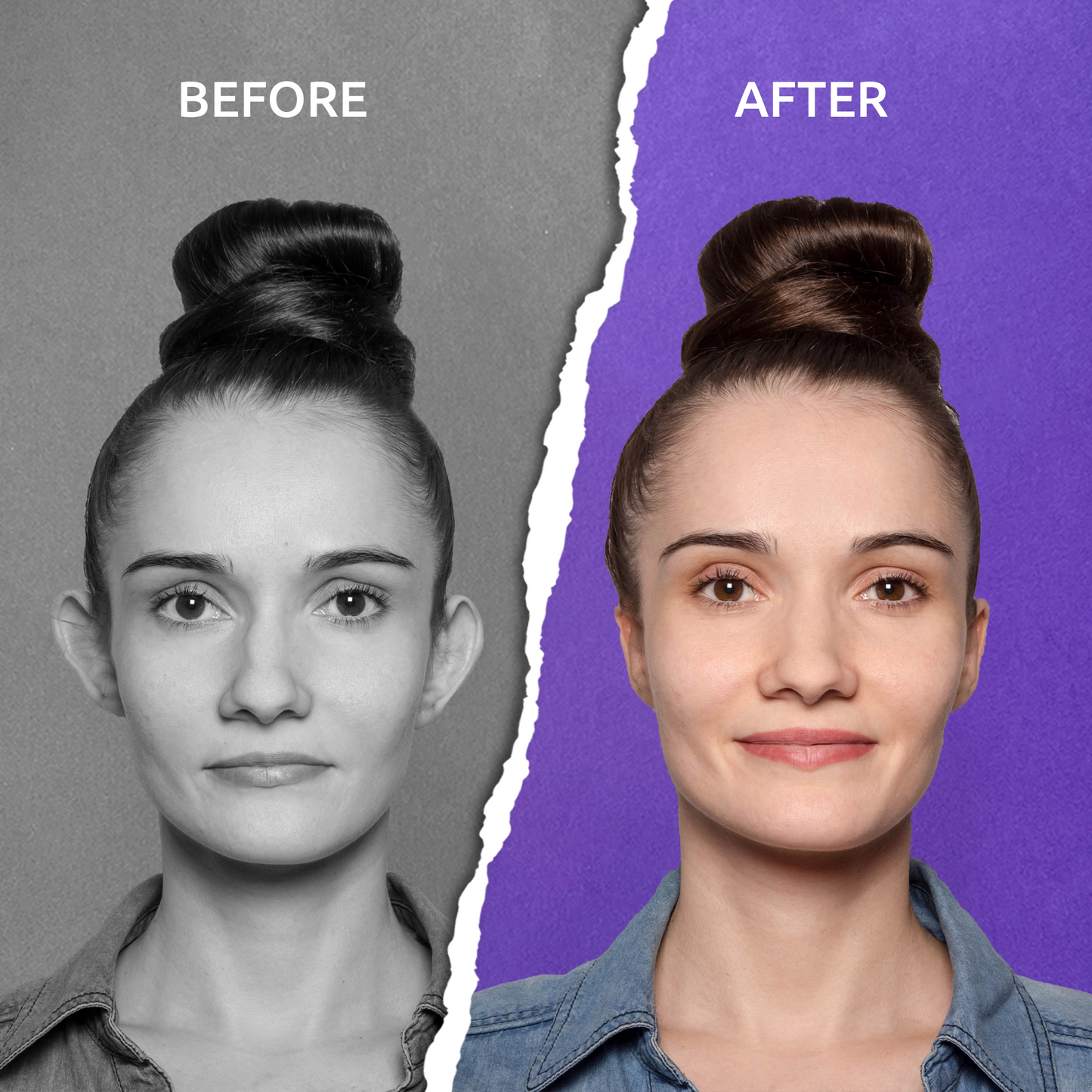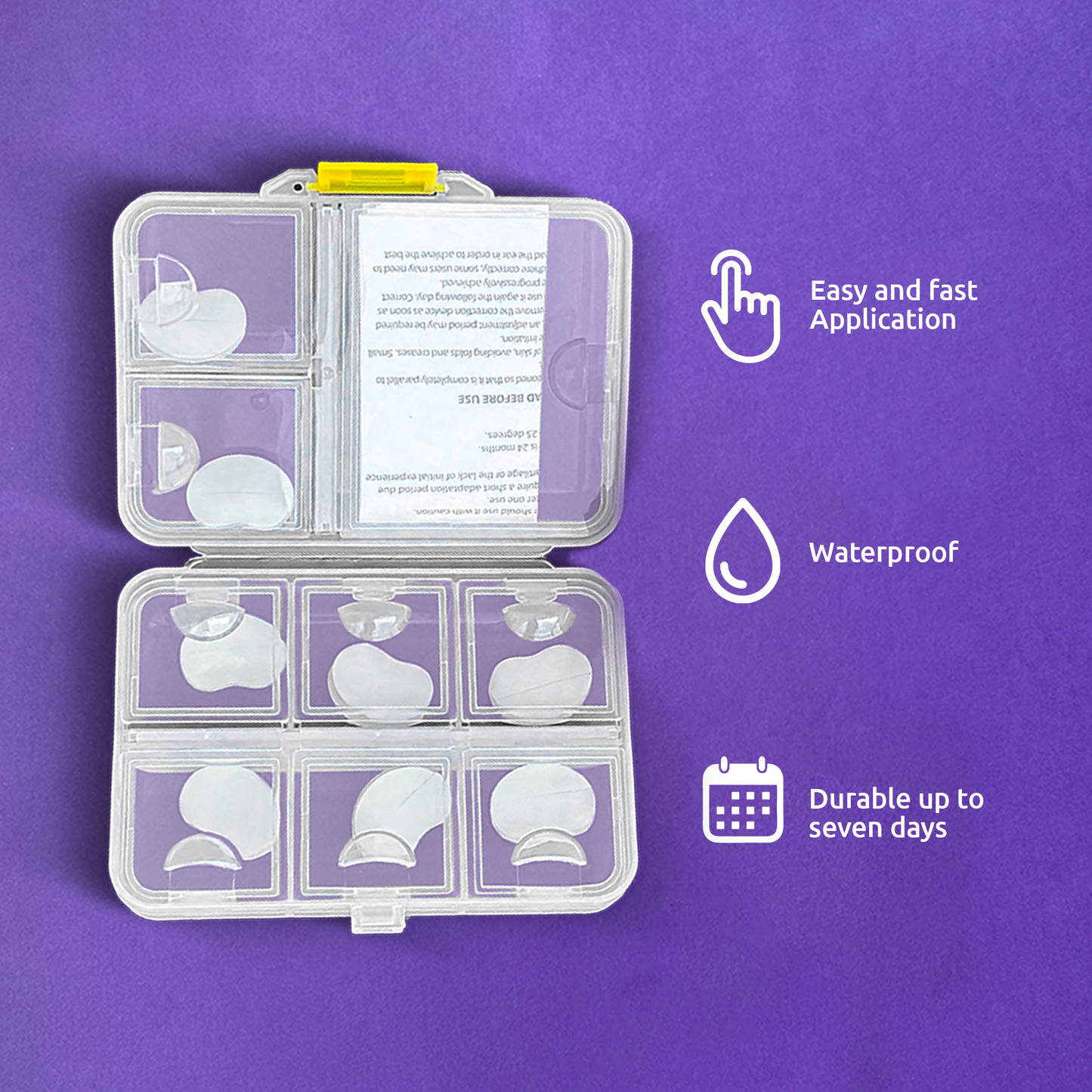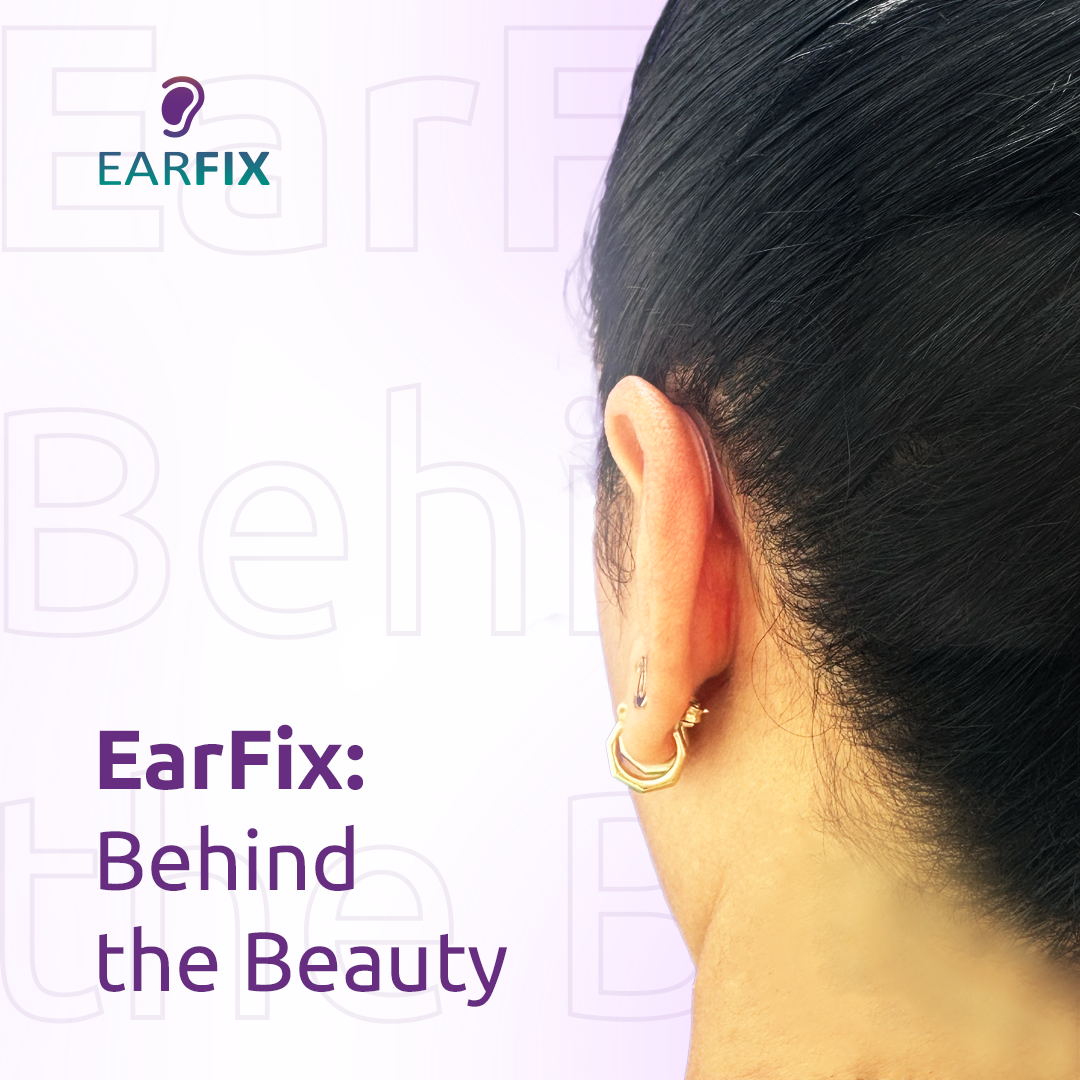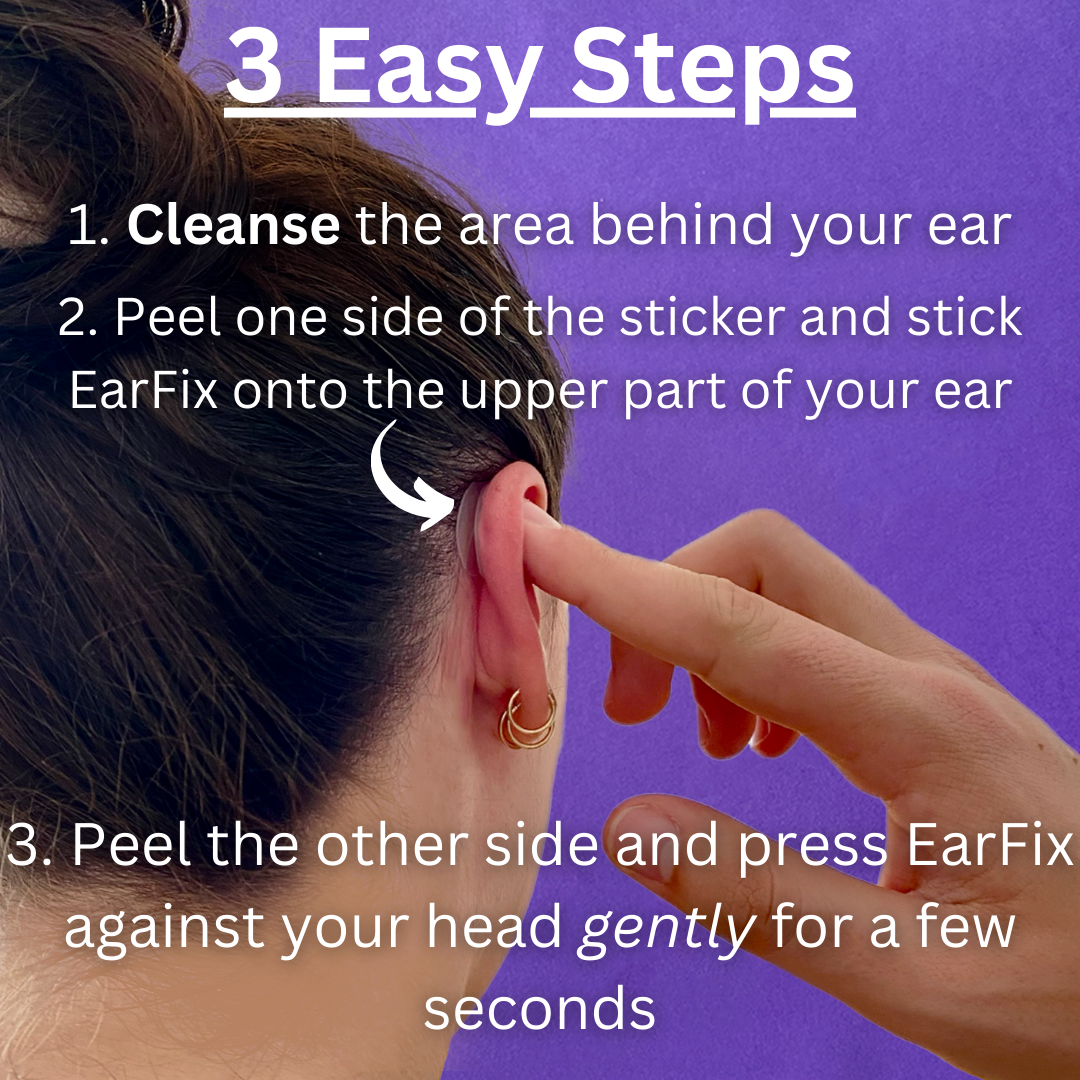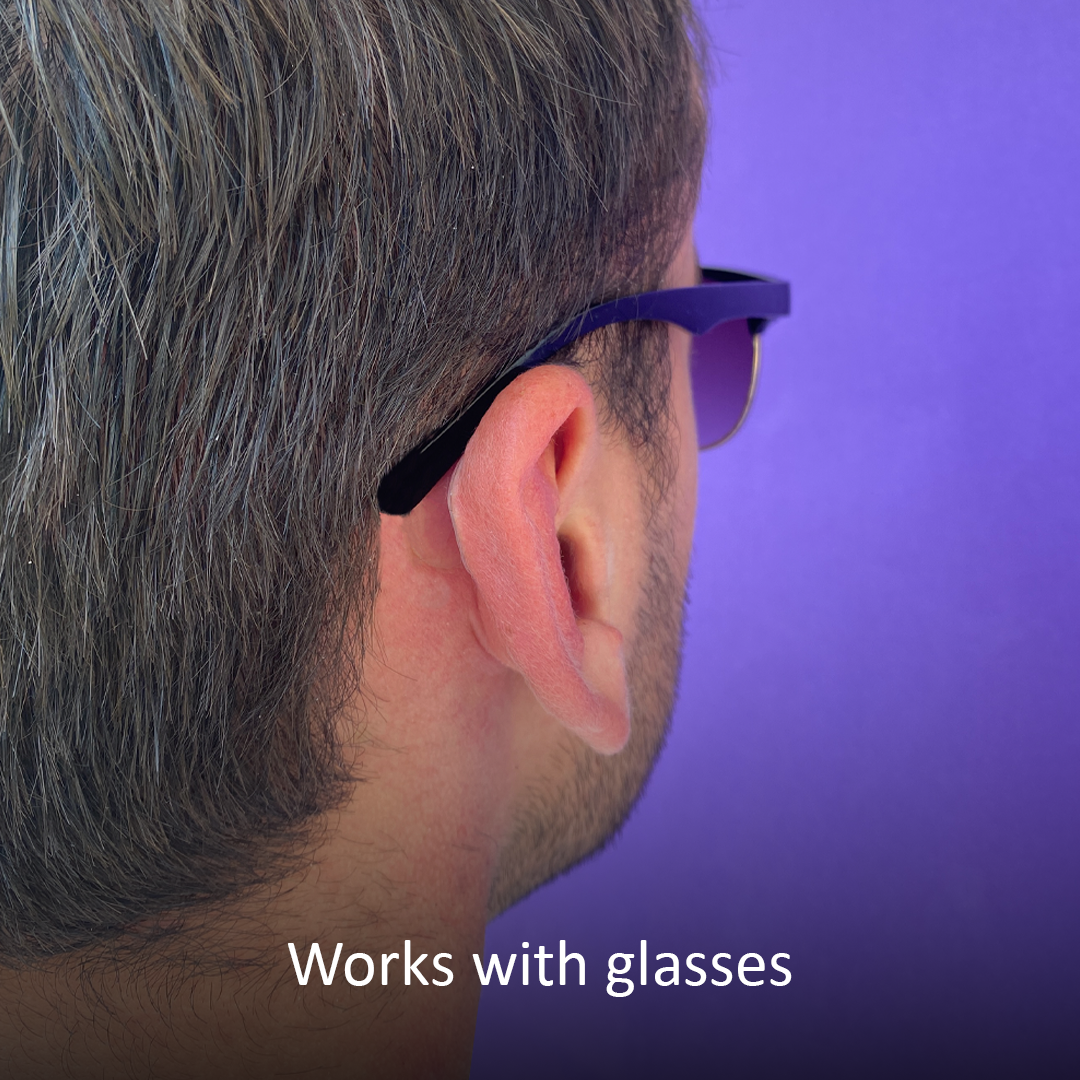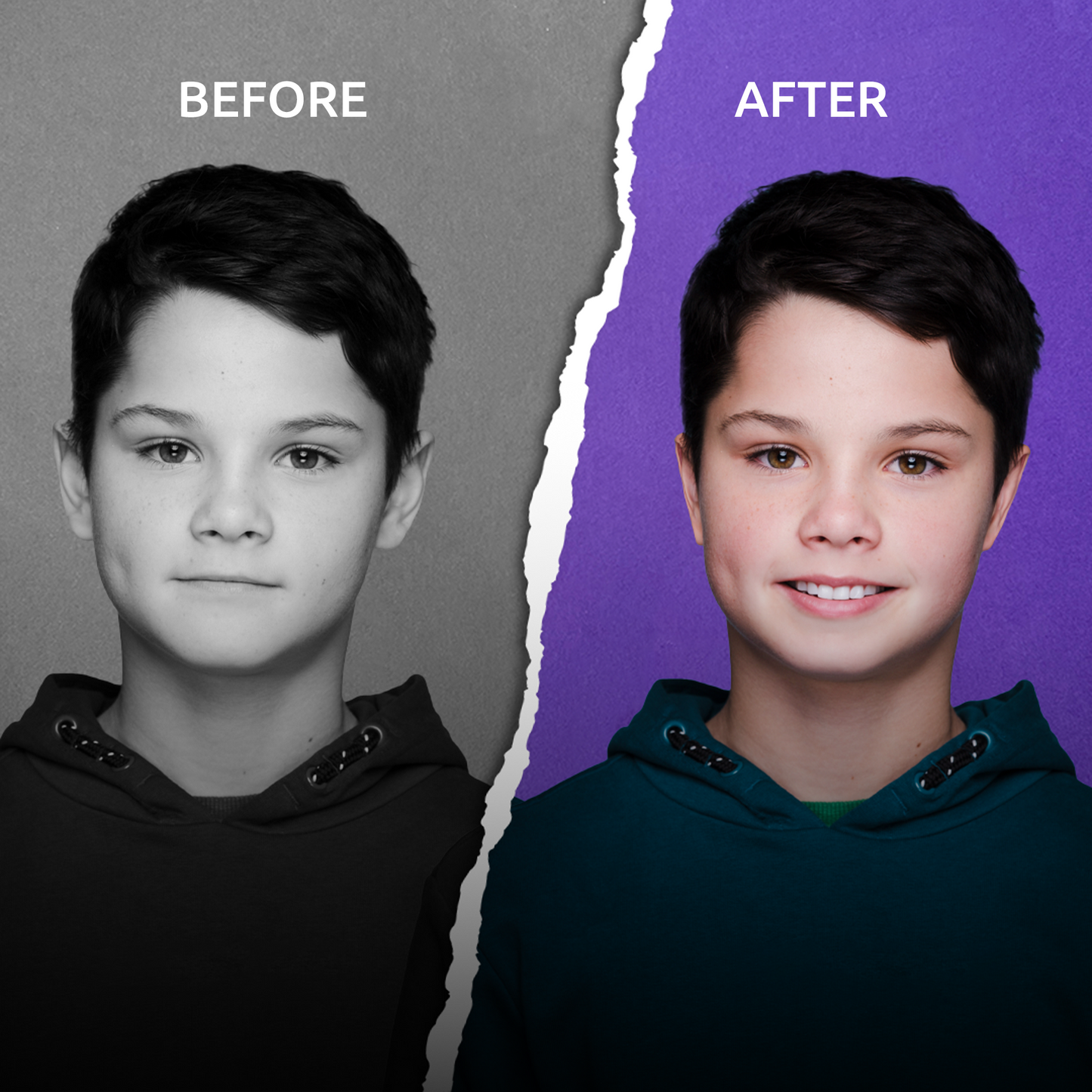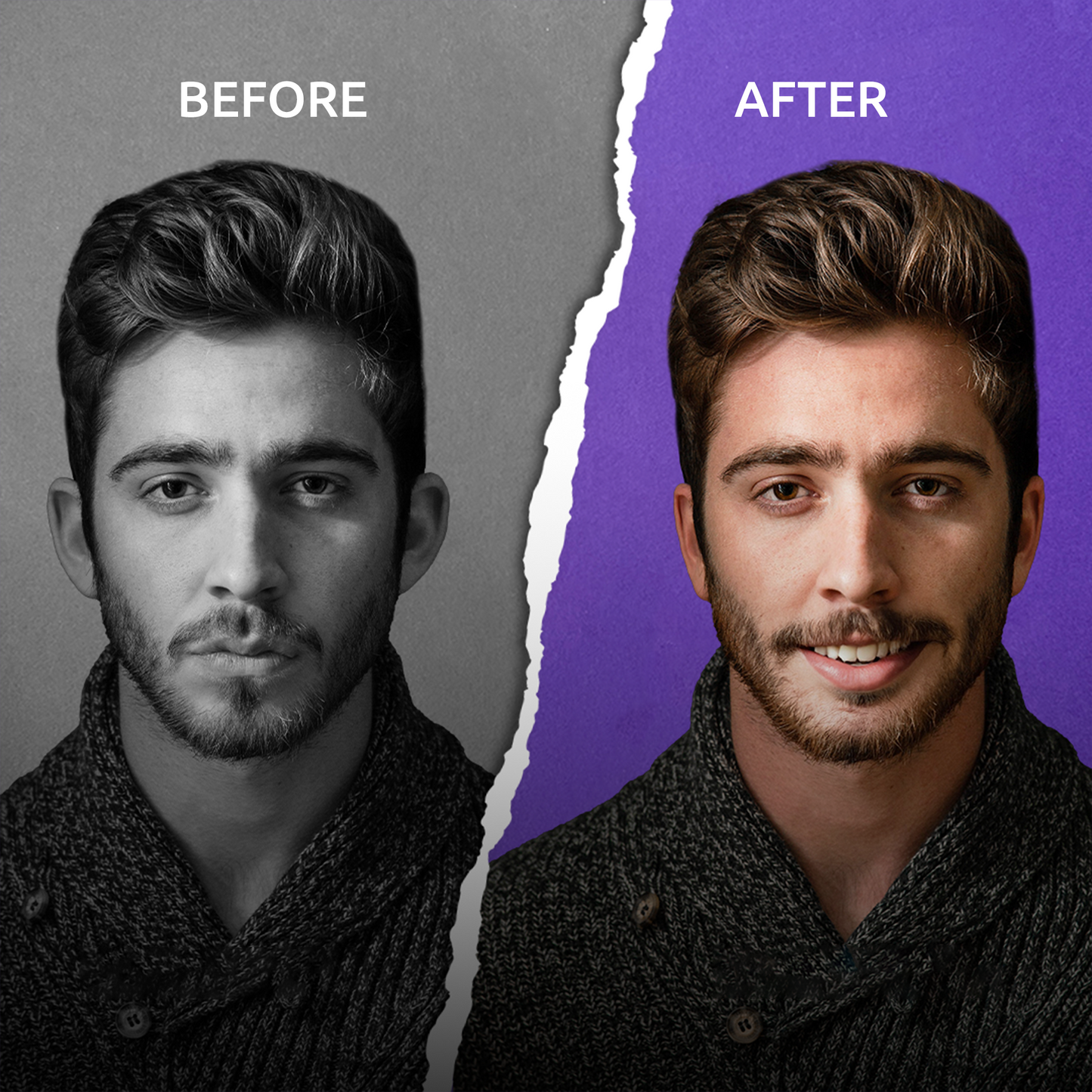If you're considering otoplasty, one of the first questions that probably comes to mind is, "What's the recovery really like?" While the full healing process for surgery can take up to six to eight weeks, the good news is that most people feel ready to jump back into their normal routines, like work or school, in just one to two weeks. But what if you could skip the recovery entirely?
Understanding both the surgical timeline and the non-surgical alternatives is key to choosing the path that’s right for you. Let's explore what healing from otoplasty involves and how a non-invasive solution like EarFix offers an instant, pain-free alternative.
A Realistic Look at Otoplasty Recovery
Going forward with ear surgery is a big decision, and knowing what to expect during the healing journey is key to feeling prepared. Otoplasty isn't a quick fix; it requires a bit of patience. You can expect some swelling and tenderness, and you'll need to wear protective headwear for a few weeks. This is crucial for making sure your ears heal correctly in their new, desired position.
Of course, everyone's healing timeline is a little different and depends on things like your age and the exact surgical technique used. Generally, though, you'll see the final, settled shape of your ears emerge between six to eight weeks after your procedure.
To give you a clearer picture, let's break down the typical recovery process into manageable phases. This table outlines what you can generally expect at each stage.
Otoplasty Recovery Timeline At a Glance
| Recovery Phase | What to Expect | Activity Level | Key Care Instructions |
|---|---|---|---|
| First 24-48 Hours | Peak swelling, discomfort, and bruising. A bulky compression bandage will be in place. | Rest is essential. No strenuous activity. | Keep your head elevated, take prescribed pain medication, and do not touch or remove the bandage. |
| Week 1-2 | Swelling and bruising start to fade. The initial bandage is replaced with a lighter headband. | Light activity is okay (e.g., walking). Avoid any contact sports or heavy lifting. | Wear the headband as instructed (often 24/7 at first), keep incisions clean and dry. |
| Week 2-4 | Significant reduction in swelling. Ears will still be sensitive. | You can slowly return to more normal activities, but still avoid anything that could impact the ears. | Continue wearing the headband, especially at night, to protect the ears while sleeping. |
| Week 4-8 | Most swelling is gone. The new ear shape becomes more defined and feels more natural. | Most activities can be resumed, but get your surgeon’s approval for contact sports. | You can typically stop wearing the headband. The ears are still healing internally, so remain careful. |
As you can see, the most intensive part of recovery is front-loaded into the first couple of weeks. After that, it's a steady path toward your final results.
Your Healing Journey Visualized
Sometimes a picture makes it all click. This timeline gives you a quick visual guide to the key phases of otoplasty recovery.
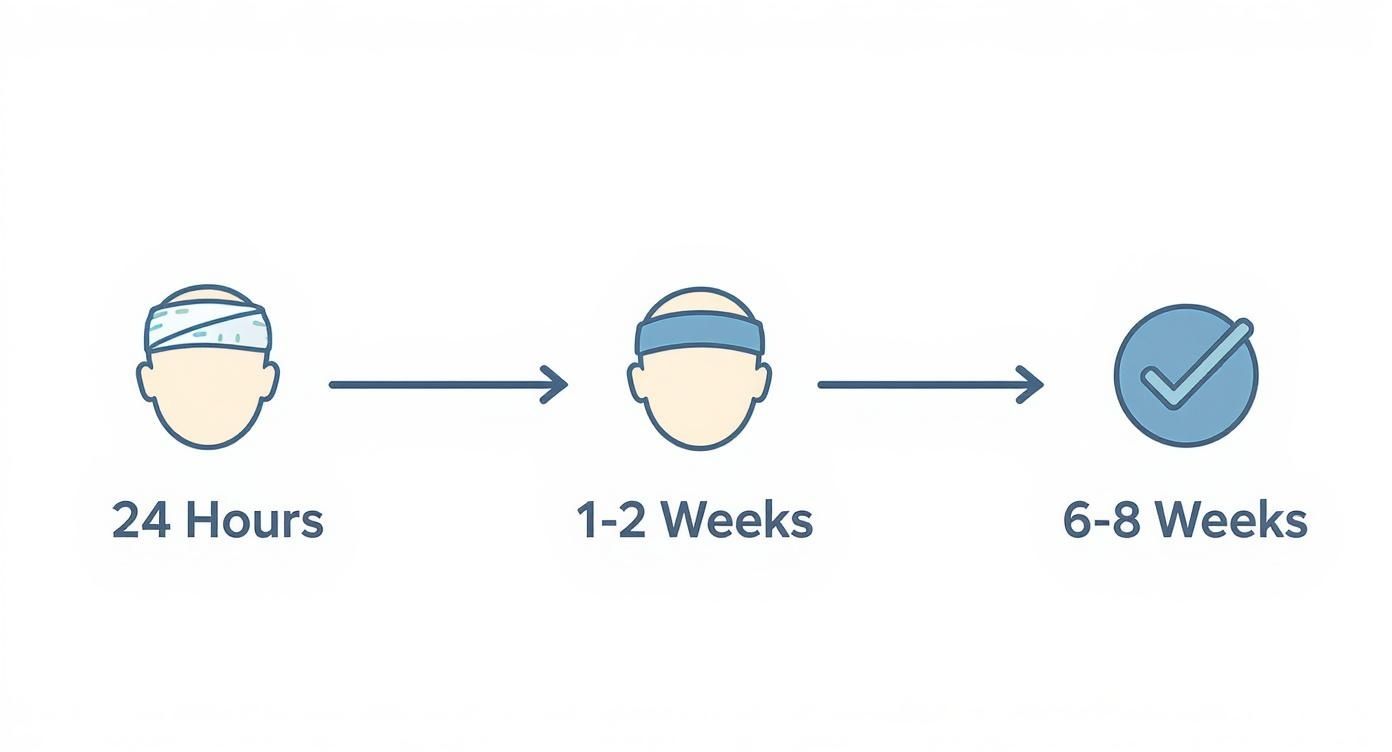
It really highlights how the initial period with bandages and discomfort quickly transitions to a more manageable phase, with gradual improvements leading to a full recovery.
The Non-Surgical Otoplasty Alternative
If a recovery that spans several weeks sounds like a dealbreaker, it's good to know there are other paths. The biggest advantage of non-surgical solutions is the total lack of downtime. For anyone looking for a prominent ears solution without the commitment of surgery, EarFix offers an instant, pain-free alternative. These are discreet, medical-grade ear correction stickers that give you immediate cosmetic improvement with zero recovery time.
- No Bandages or Headbands: You just apply the nearly invisible correctors and get on with your day. They are comfortable and designed for real-life usability.
- Zero Downtime: Head back to work, school, or social events right away. Feel confident in photos in seconds.
- Pain-Free Confidence: Get the look you want without any of the discomfort, making ear correction feel accessible and easy.
This makes products like EarFix a fantastic, affordable choice for special events, photos, or even just for daily wear. You can get that confidence boost in seconds, not months. Our guide on EarFix vs Surgery dives deeper into these differences.
A Gentle Baby Ear Corrector
For new parents, the thought of any surgery for their infant can be completely overwhelming. That’s why a safe, non-invasive option is so reassuring. EarFix provides a gentle baby ear corrector that’s specifically designed for the delicate skin of newborns. It's made with dermatologist-tested, hypoallergenic materials that are completely safe. The soft adhesive helps guide the pliable cartilage into a more natural position without any invasive procedures. This approach puts your baby’s comfort and safety first while offering a simple, effective cosmetic solution. You can read some inspiring Customer Stories from parents who chose this gentle path.
Ultimately, understanding the recovery timeline for otoplasty helps you weigh all your options. If immediate results and zero downtime are your top priorities, a non-surgical solution could be the perfect fit.
Navigating The First Two Weeks After Surgery
The first two weeks are, without a doubt, the most critical part of your otoplasty recovery. This is when your body kicks into high gear to start healing, so your main job is simply to rest and let it happen. You'll head home from surgery with a pretty bulky, soft dressing wrapped around your head, which is there to keep your ears stable and protected in their new position.

It’s completely normal to feel some discomfort and see swelling and bruising during these first few days. Your surgeon will send you home with pain medication to keep you comfortable, and it’s really important to take it on schedule. Think of that initial dressing as a protective helmet for your ears—just leave it be and focus on relaxing with your head elevated to help bring the swelling down.
The First Follow-Up and The Headband Transition
Around day seven, you'll have your first follow-up appointment. This is a big one. Your surgeon will carefully remove that initial bulky dressing to see how everything is healing. It’s the first time you’ll get to peek at your new ear shape, but keep in mind, they’ll still be pretty swollen at this point.
After this check-up, you’ll trade the big bandage for a much lighter, softer headband, kind of like what you’d wear for sports. This headband is non-negotiable because it continues to shield your ears from getting accidentally bumped or bent out of shape, especially when you're asleep. Expect to wear it 24/7 for this second week.
Most people find they can get back to light-duty work or school within this one-to-two-week window, as long as they stick to their post-op instructions. The headband basically acts as a splint for the healing cartilage, which needs to be held steady in its new spot, much like a bone in a cast. You can dig into more clinical details on post-operative otoplasty care.
An Easier Path with Ear Correction Stickers
If the thought of bandages, discomfort, and two weeks of downtime feels a little daunting, it's good to know there are non-invasive options out there. Instead of going through a surgical recovery timeline, you can get the look you want instantly, with zero pain.
EarFix ear correction stickers offer a completely different experience:
- Zero Recovery: You just apply the discreet stickers and go on with your day. That’s it.
- No Pain or Discomfort: The whole process is external and gentle on your skin.
- Complete Freedom: There are no activity restrictions, no headbands to wear, and no special sleeping rules.
This makes EarFix an amazing prominent ears solution for anyone who wants that confidence boost right away, without the downtime and commitment of surgery.
Practical Tips for Comfort During Early Recovery
Getting through these first couple of weeks is all about managing your comfort and protecting your final result. Here’s what people who’ve been through it often recommend:
- Sleeping: Prop your head up on two or three pillows and sleep on your back. This position helps a ton with swelling and makes sure you don’t accidentally roll over onto your ears.
- Clothing: Stick with button-down shirts, zip-ups, or anything that doesn’t have to be pulled over your head. Trust me, you don't want to snag your healing ears.
- Activities: Keep things mellow. Gentle walking is great, but skip anything that could get your blood pressure up or put you at risk of a bump to the head.
The goal of this initial phase is simple: give your body the best possible environment to heal. By following your surgeon's instructions and being gentle with yourself, you're setting the stage for a smooth journey and beautiful, long-lasting results.
This period definitely requires some patience, but it's just a temporary step on the path to your final look. Of course, if you're looking for that confidence boost now without any of the healing, exploring a non-surgical option like EarFix might be the perfect move. Ready to see just how easy it is? Check out our guide on How to Use EarFix.
The Zero Downtime Alternative To Ear Surgery
After walking through the whole surgical recovery—the bandages, the discomfort, and weeks of sitting on the sidelines—it's pretty clear that otoplasty is a major commitment. But what if you could get that same confidence boost without any of the healing time? Let's talk about a totally different way to approach ear correction.
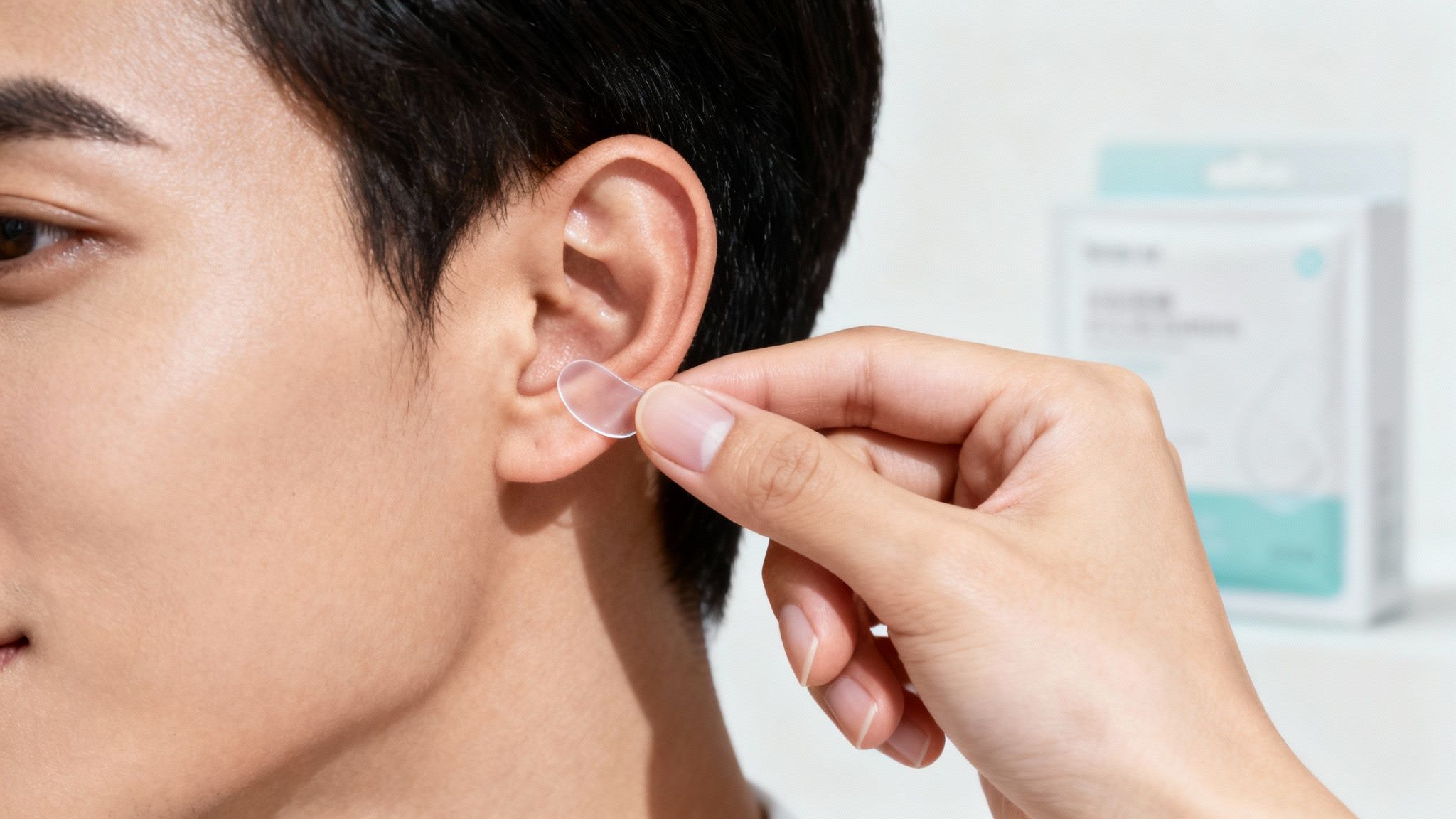
This is where a non-surgical approach really shines, giving you instant results with absolutely zero downtime. Instead of a recovery that drags on for weeks, imagine a pain-free fix you can apply in seconds, right from the comfort of home.
The Power of Ear Correction Stickers
EarFix offers a simple but incredibly effective prominent ears solution using discreet, medical-grade adhesive correctors. Think of them as invisible little supporters for your ears. One side sticks to the back of your ear, and the other sticks to the skin on your head, gently pulling the ear closer for a more natural look.
The real beauty here is how simple and immediate it is. No incisions, no anesthesia, and definitely no healing required. You can go from feeling a bit self-conscious in photos to totally confident in the time it takes to put on a sticker. It's a game-changer for daily wear, special events like weddings or graduations, or any time you just want to feel your absolute best.
"The ability to instantly change something that has bothered you for years, without pain or recovery, is incredibly freeing. It's about giving you control over your appearance on your own terms."
This method puts you in the driver's seat. You get to decide when to wear them and for how long, which is a level of flexibility surgery just can't offer. If you're wondering how to fix ears that stick out without surgery, our detailed guide gives you even more insight into this simple method.
A Gentle and Safe Baby Ear Corrector
For new parents, the idea of surgery for their baby can be completely overwhelming. The good news is, for infants, a non-invasive approach is often incredibly effective. A newborn's ear cartilage is super soft and pliable, which means it responds really well to gentle, consistent positioning.
EarFix has a specially designed baby ear corrector that is safe, gentle, and it works. It’s made from dermatologist-tested, hypoallergenic materials that are kind to a baby’s delicate skin. The soft silicone and skin-safe adhesive work together to guide the ear cartilage into a more typical shape during those first few months of life when it's most malleable.
This gives parents a proactive, pain-free way to address concerns about prominent or folded ears early on, all while keeping their baby’s comfort and safety the top priority. No scary procedures—just a simple, gentle solution.
How Non-Surgical Otoplasty Compares
When you put EarFix side-by-side with surgical otoplasty, the difference in the experience is night and day. One path involves a serious investment of time, money, and physical recovery. The other offers immediate gratification with no strings attached.
Let's break it down:
- Recovery Time: Surgery means 4-8 weeks of healing. EarFix takes zero seconds. You apply it, and you're done.
- Pain and Discomfort: Otoplasty recovery comes with soreness and tenderness that you'll manage with medication. EarFix is 100% pain-free.
- Cost: Surgical procedures can set you back thousands of dollars. EarFix is a refreshingly affordable alternative.
- Commitment: Surgery is a permanent, irreversible decision. EarFix is a temporary, flexible solution you can use whenever you feel like it.
This isn't about which option is "better," but about what’s right for your lifestyle and goals. For anyone looking for a cosmetic improvement without the full medical commitment, the choice is pretty clear.
EarFix gives you the power to feel confident right away, whether you're an adult looking for a discreet fix or a parent wanting a gentle option for your child. It makes ear correction feel accessible, safe, and easy.
Healing From Week Three To The Final Result
Once you hit week three of your otoplasty recovery, you can finally breathe a sigh of relief. The toughest part of the healing process is officially in the rearview mirror. This is the stage where your patience really begins to pay off, shifting from active recovery to simply protecting your ears while your body handles the rest.
The constant soreness and major swelling that defined the first couple of weeks will start to fade. In its place, you’ll notice a much more manageable tenderness. Your ears will begin to feel less like a delicate surgical site and more like they belong to you again—a huge milestone in the healing journey.
A Gradual Return To Normalcy
One of the biggest changes you'll notice is your relationship with that protective headband. After wearing it around the clock for the first two weeks, your surgeon will likely give you the thumbs-up to wear it only at night starting from week three.
Don't underestimate this step, though. That headband is still doing an incredibly important job, acting as a shield while you sleep. Think of it as nighttime insurance for your investment, preventing you from accidentally bending or putting pressure on your ears.
Resuming Activities With Care
Even though you’ll be feeling a whole lot better, it’s not quite time to jump back into your old routine. Your ears are still healing on the inside, and the cartilage needs more time to set firmly in its new position.
- Light Exercise: Gentle activities are your friend here. Think walking or hopping on an elliptical. These get your blood flowing without putting your ears at risk.
- Avoid Contact Sports: This one is a non-negotiable. Activities like soccer, basketball, or any martial arts are off the table for at least six to eight weeks, or whenever your surgeon gives you the all-clear. A direct hit could easily undo all the progress you've made.
- Listen to Your Body: This is key. If any activity causes throbbing or pain in your ears, that’s your body’s way of telling you to stop and take it easy.
Your final result is a marathon, not a sprint. Protecting your ears from trauma during this crucial healing window ensures the outcome you've been waiting for.
The Zero-Downtime Confidence Boost
Let's be honest—navigating weeks of modified activities and nighttime headbands is a serious commitment. For anyone who wants that aesthetic confidence boost without the long healing process, a non-surgical otoplasty solution like EarFix offers an immediate, hassle-free alternative. Instead of waiting months for your final look to settle in, you can get there in seconds.
EarFix delivers that confident feeling without interrupting your life at all. You can hit the gym, sleep normally, and go about your day without any of the restrictions that come with surgical recovery. For many, this is the perfect prominent ears solution. You can discover the freedom of instant results by visiting earfixusa.com or finding EarFix on Amazon.
Recognizing Complications During Recovery
While otoplasty is a very safe and routine procedure, knowing the difference between normal healing and a potential red flag is empowering. This section isn’t meant to scare you; it’s about giving you the confidence to navigate your recovery smoothly.
Think of it this way: some swelling, bruising, and even itching are totally normal. That's just your body doing its job to heal. But a few specific signs mean it’s time to pick up the phone and call your surgeon.
When To Call Your Doctor
Trust your gut—if something just feels off, it’s always better to get a professional opinion. Following your aftercare instructions is your best defense, but keep an eye out for these specific signs:
- Sudden Spike in Pain: Your pain level suddenly jumps and isn't helped by your prescribed medication.
- Fever: Any temperature reading over 101°F (38.3°C) could signal an infection.
- Unusual Drainage: A little bit of clear or pinkish fluid is one thing, but thick, yellow, or foul-smelling drainage is a major warning sign.
- Excessive Swelling or Firmness: If one ear becomes much more swollen, hard, or painful than the other, it could be a hematoma—a pocket of blood that has collected under the skin.
A hematoma is one of the more common early complications, and catching it early is critical. Prompt attention prevents bigger issues that could really set back your otoplasty recovery time.
A Stress-Free Alternative With Zero Complications
Navigating the recovery process, even when the risks are small, can be a source of anxiety. This is where a non-surgical otoplasty solution like EarFix really shines.
Since it’s a completely external and non-invasive cosmetic corrector, it sidesteps all surgical risks entirely.
With EarFix, you get the aesthetic improvement you're looking for without worrying about infection, hematomas, or healing complications. It's a simple, safe way to feel more confident.
There's no downtime and no recovery period to watch over. You just apply the discreet, dermatologist-tested ear correction stickers and get on with your life, completely worry-free.
This approach is especially reassuring for parents considering a baby ear corrector, as it provides a gentle, safe solution without any medical procedures involved. You can explore a full breakdown in our guide to otoplasty cost, risks, benefits, and alternatives.
Ultimately, being informed is key, whether you choose surgery or a non-invasive option.
Life After Recovery: Long-Term Confidence
After the otoplasty recovery time has passed and everything has healed, the focus finally shifts from aftercare to just… living. Those weeks of patience and careful healing pay off, revealing a new look that often brings a serious boost of confidence. Life after recovery is less about healing and more about feeling completely free in your own skin.

While the intensive aftercare is over, a little long-term care still goes a long way. Protecting your ears from hard impacts during sports is always a good idea, and a bit of sunscreen on the faint incision lines helps them fade beautifully. But for most people, the biggest change is emotional—the freedom to wear any hairstyle, take a photo from any angle, and simply stop thinking about their ears.
The Instant Confidence of a Non-Surgical Fix
If reading about the surgical timeline felt a bit daunting, let's go back to a much simpler path. You don't actually have to wait weeks or months to get that surge of confidence. EarFix provides that feeling instantly, with zero recovery period.
That's the beauty of a prominent ears solution designed for modern life. It’s for anyone who wants immediate results without the commitment, cost, and discomfort of a full surgical procedure.
How Ear Correction Stickers Can Empower You
Think of EarFix as a tool for confidence, not just a product. These discreet, skin-safe ear correction stickers offer a totally different experience—one that is pain-free, non-invasive, and affordable. They give you the power to create your desired look entirely on your own terms, whether it's just for a special event or for everyday wear.
- Feel Great in Photos: Pose from any angle, knowing you love the way you look.
- Enjoy Total Comfort: Made from soft, dermatologist-tested materials, EarFix is comfortable enough for daily use.
- Empower Your Kids: For parents, EarFix offers a gentle baby ear corrector that is safe and effective. It’s a proactive solution that avoids any kind of medical procedure. You can see what other families have experienced by reading our Customer Stories.
Achieving the look you want shouldn't have to be a long, drawn-out process. A simple, non-invasive solution can change your daily life by giving you an immediate boost in self-assurance and comfort.
The journey to feeling good about your appearance doesn't always need a lengthy recovery. In fact, it can start right now, in just a few seconds. By comparing the surgical journey with an instant solution like EarFix, you can make the choice that truly fits your lifestyle. Our guide on EarFix vs Surgery breaks down the comparison even further.
Ready for an immediate confidence boost? Explore EarFix on earfixusa.com or find us on Amazon.
Your Questions Answered About Recovery And Alternatives
When you're thinking about otoplasty, the recovery details can feel a bit overwhelming. It's totally normal to have a ton of practical questions. At the same time, you're probably wondering where non-surgical options fit into all of this. Let's clear things up with some straight-to-the-point answers to help you feel confident about your path forward.
When Can I Wash My Hair After Otoplasty?
Most surgeons will tell you to wait until your main head dressing comes off, which is usually about a week after the procedure. Even after that, you'll have to be super gentle and avoid letting the incisions get soaked for a little while longer.
Contrast that with a prominent ears solution like EarFix, where there are zero restrictions on your daily routine. You can shower and wash your hair like you always do—just make sure your skin is completely dry before putting on a new corrector.
How Painful Is Otoplasty Recovery?
Let's be real: discomfort is part of the otoplasty recovery time, especially for the first few days. Most people describe it as a steady, dull ache that you can manage with the pain medication your doctor prescribes. The good news is that the pain really drops off after the first week.
If you're looking for a completely pain-free experience, EarFix is the way to go. It’s simply a cosmetic adhesive, so there’s no surgical element and no healing process involved.
Key Takeaway: A lot of people use EarFix as a no-commitment "test drive" to see the aesthetic results of ear correction. It's an affordable, painless way to get a confidence boost while you figure out your long-term plans.
How Long Do I Need To Wear The Headband?
After that first bulky dressing is removed, you'll switch to a protective headband. Plan on wearing this full-time for about one to two weeks.
After that initial period, you'll still need to wear it at night for another four to six weeks. This is just to protect your ears from getting bumped or pulled while they're still healing. This is a huge difference from a non-surgical otoplasty approach, which doesn't require any recovery headwear at all.
Can I Try EarFix Before Committing To Surgery?
Absolutely! In fact, this is one of the main reasons people come to our ear correction stickers in the first place.
Using EarFix lets you instantly see and feel what it's like to have your ears positioned differently, giving you a quick confidence boost without any strings attached. You can see just how easy it is to apply them by checking out our guide on how to use EarFix. For many, this simple experience provides all the clarity they need to decide on their next steps.
Ready to see the difference for yourself without any downtime? Explore the gentle, instant solution from EarFix USA at earfixusa.com or find us on Amazon.
